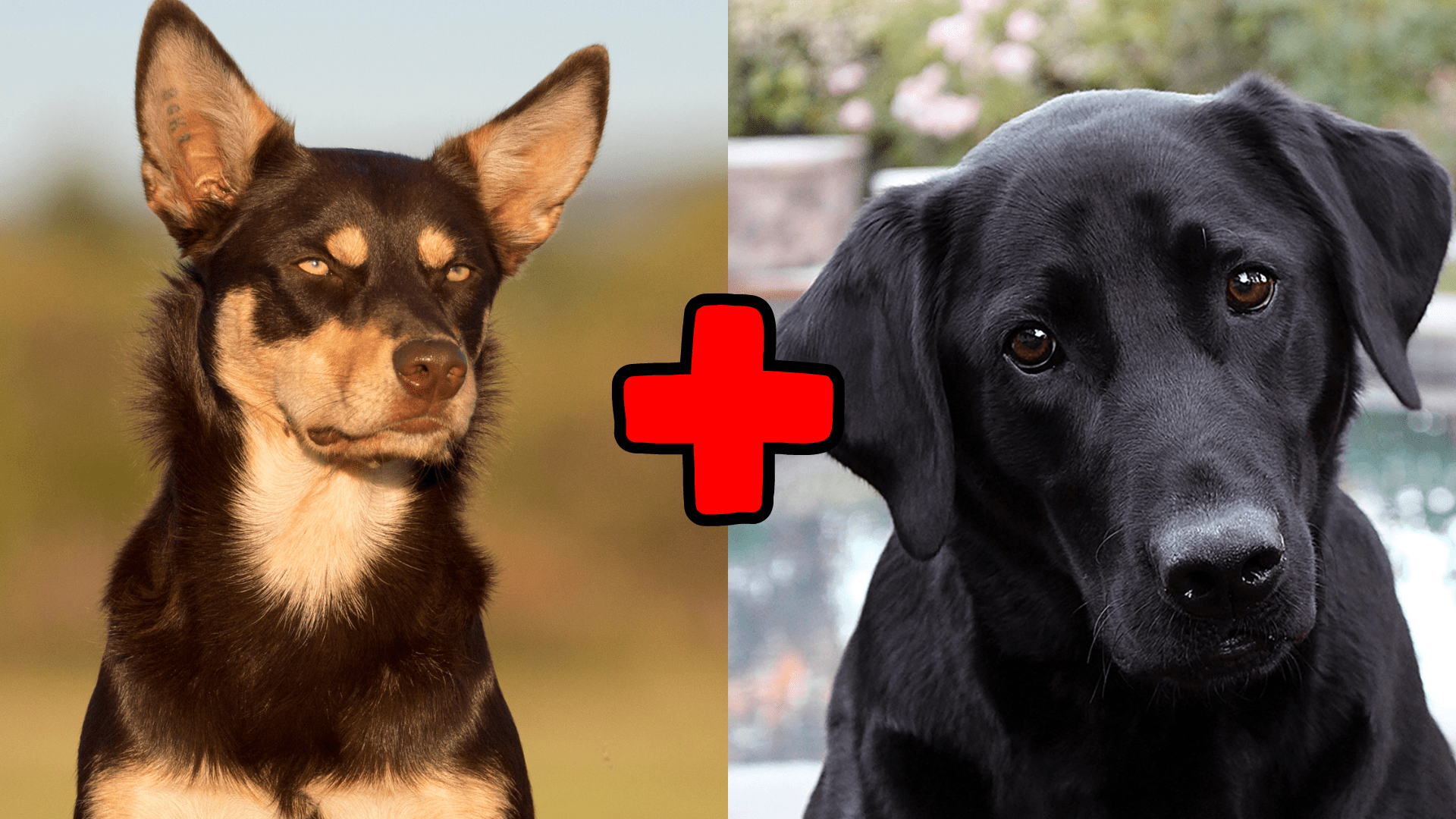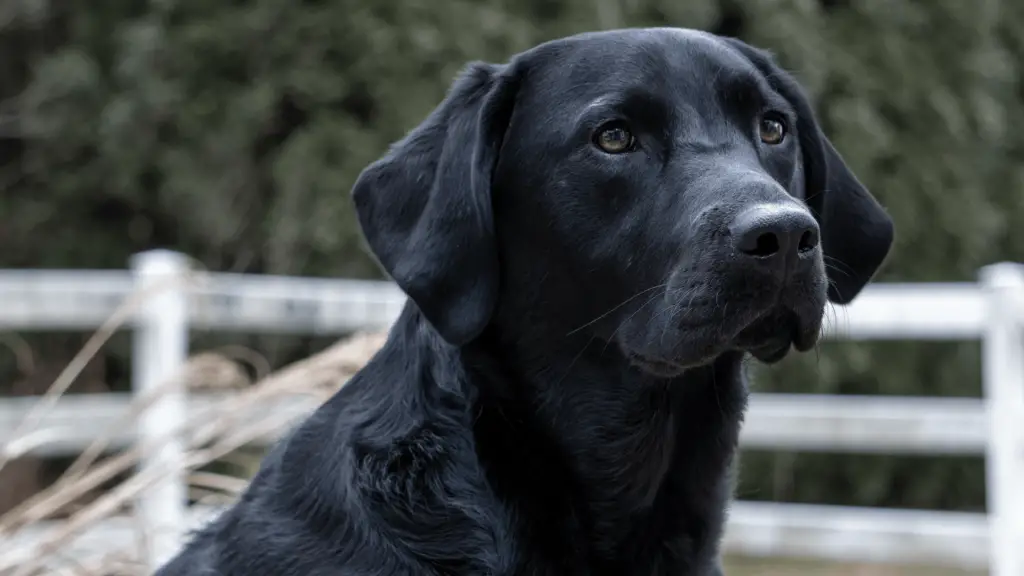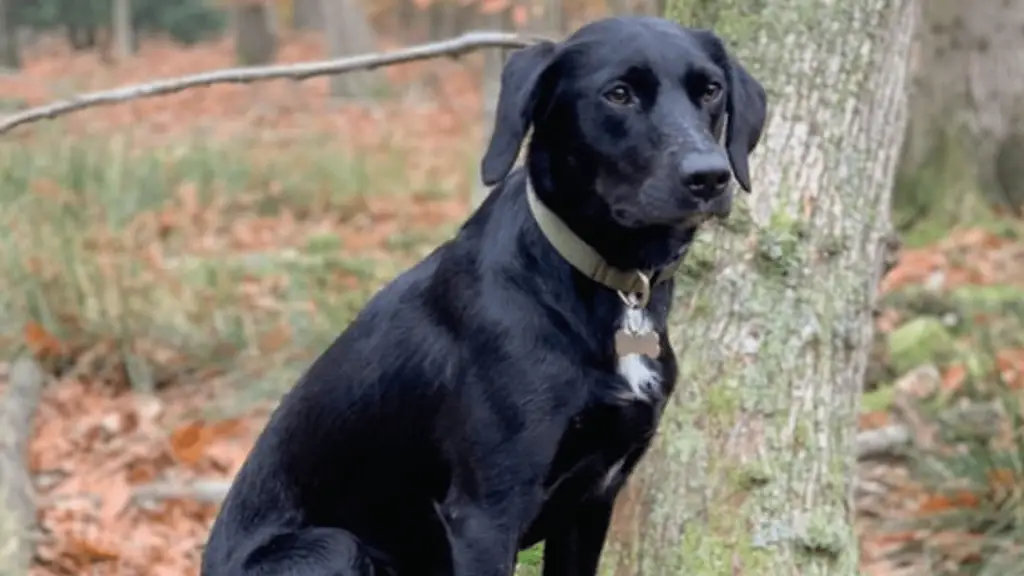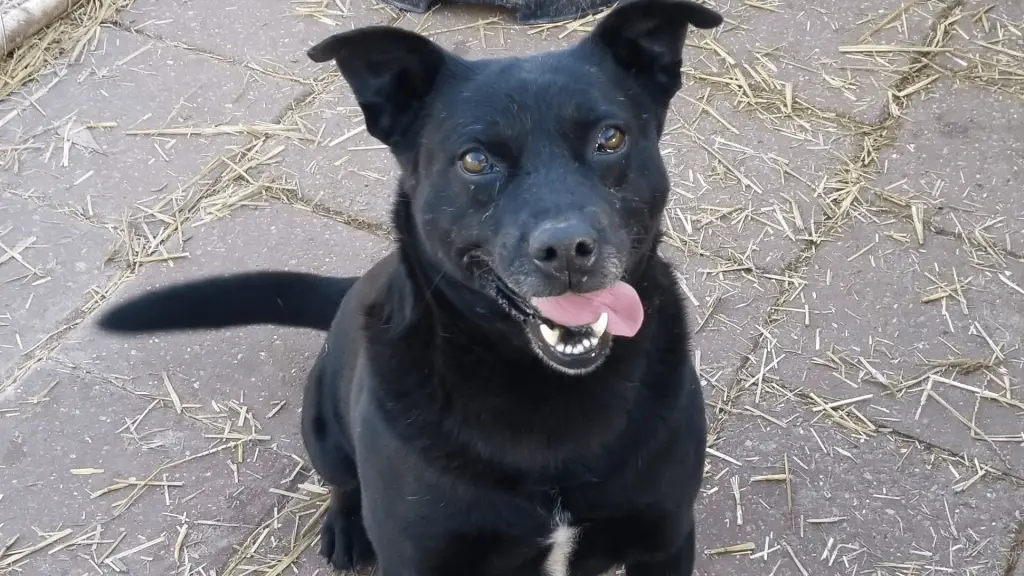Pawscessories is reader-supported. When you buy via links on our site, we may earn an affiliate commission at no cost to you.
Learn more.
The kelpie lab mix, also known as the Kelpador, is a cross between the Australian Kelpie and the Labrador Retriever. This mixed breed comprises two popular dog breeds and takes the best traits from each.
They are strong, intelligent, and loyal. Today, the Kelpador is used as a family pet or working dog due to its good looks, intelligence, and friendly nature.
This post will cover everything you need to know about this special mixed dog breed!
Table of Contents

What Is A Kelpador?
The Kelpador is a mixed dog breed developed by breeding an Australian kelpie with a Labrador retriever.
While the intention of this mixed breed is unknown, the Kelpador is an all-purpose farm dog. They are lauded for their physical strength, intelligence, and loyal temperament. They also make for a perfect companion dog.
In recent years they have become popular as family pets due to their appealing looks and temperament. However, when it comes to mixed breeds, the outcome can be somewhat unpredictable – let’s explore what you can expect from a Kelpador.
History Of The Kelpie Lab Mix?
The Kelpie Lab Mix is hardworking, intelligent, and loyal – everything you could want in a family pet. But where did this unique breed come from?
When it comes to mixed breeds like the Kelpie labrador, it’s hard to pinpoint their history. However, we can look at the parent breeds’ history to better understand this mix.
Labrador Retriever History

The Lab Retriever is an ancient dog breed that originated in Newfoundland in the 1500s. They caught fish from the icy seas and helped with hunting on land.
These dogs were limited to the Newfoundland region for more than two centuries, after which they were taken to England. In 1830 these dogs were declared one of the best hunting companions and renamed Labradors by the Earl and Duke of Malmesbury.
Labrador Retrievers are hardworking and loyal dogs always eager to please their human families. Labs were first brought to the United States in the 1900s and eventually became popular in hunting or farming families.
Kelpie History
The Australian Kelpie is descended from a Scottish coolie and Dingo, an indigenous Australian farm dog. In the late 1800s, Scottish collies were brought to the country for herding sheep.
The Kelpie was bred to evolve the collie so they could handle the harsh Australian climate while being able to work with farmers for extended periods. The breeding process of Australian Kelpies has been vastly successful, to the point where they have become a household name for working dogs.
The Kelpie is a hardworking, clever, and independent dog with a reliable work ethic and unwavering devotion. Many farmers in Australia still own an Australian Kelpie or a Kelpie crossbreed to assist them on the farm and manage the livestock.
Kelpie Lab Mix

The mixed breed has many of the same characteristics as its parent breeds. Here are a few common features of the Kelpie X Lab:
- Intelligence
- Affectionate
- Loyal
- Obedient
- Great working dog
- Active and energetic
- Playful
- Friendly unless threatened
Although it’s unknown the exact reasons for why this mixed breed came to be, based on the parent breed histories, we can make some guesses.
The Kelpie Lab mix was likely bred to create a dog with all the best features of each parent breed. This mix would be an intelligent, affectionate, loyal, and obedient dog. Make this mix excellent for being a working dog or a loving companion.
Kelpador Dog Appearance & Build

The Kelpie mix can come in a large variety of sizes, colors, and shapes – since they are a mixed breed, it’s impossible to predict exactly what they will look like.
They take genes from both parents. However, what genes are actually expressed is fairly random with mixed breeds.
However, there are some general trends with the Kelpador. Kelpie lab mixes tend to have a muscular build with long legs and a thick coat that can be either short or medium in length.
The most common colors for Kelpador’s are black, brown, or chocolate. This is because black and brown coat colors are usually dominant traits, overriding most lighter colors. However, they can also come in yellow, red, or cream like their Labrador parent.
The Lab Kelpie mix can have a variety of eye colors but usually has brown or amber eyes. Their ears can be floppy like labradors, erect like the Australian Kelpie, or in between.
Kelpador Size (Weight & Height)

There is no set standard for this mixed breed, so they can vary in size. However, most Kelpie Lab mixes will fall in the medium to large range.
Their average weight can range anywhere from 30 – 70 pounds, and their height is usually 18 – 222 inches tall. However, there is always the potential for them to be larger or smaller than this. Females will fall on the smaller side and males on the large side.
Here is a quick breakdown of the average size ranges for both parent breeds:
- Labrador weight: 55 to 80 pounds, height: 21.5 – 24.5 inches tall.
- Australian Kelpie weight: 25 – 46 pounds, height: 18 – 20 inches tall.
So, anywhere between these ranges is possible for a Kelpador, but they tend to lean closer to the lab parent.
Kelpie Lab Mix Shedding & Grooming
The Labrador is an average shedder, and the Kelpie is a heavy shedder. Therefore, it’s likely that your Lab Kelpie mix will fall somewhere in the middle when it comes to how much they shed.
However, the Lab and Kelpie are relatively low-maintenance dogs aside from some shedding. So expect Kelpie Lab mix to be fairly low maintenance aside from brushing their coat once a week. This will also help reduce shedding and keep their coat looking healthy and shiny.
Many parents of this mixed breed choose to get a robot vacuum to keep track of all their shedding. It’s also suggested that you blow out their coat during the seasons when they shed the most (typically spring and fall).
You can use a dog blow dryer to help get rid of a large amount of their dead or loose fur before it finds its way all over your house.
As for other forms of grooming and maintenance, they will require bathing, nail trimming, ear cleaning, and teeth cleaning when needed.
Are Kelpie Lab mixes hypoallergenic?
Both the Lab and Kelpie are not hypoallergenic. Therefore, their offspring, the Kelpador, would also not be hypoallergenic.
This means that if you’re allergic to dog dander, you will have allergic reactions being around a lab kelpie mix.
Kelpador Lifespan
The Kelpie Lab mix has a lifespan of 11 to 13 years. This is the middle of the average lifespan for both parent breeds.
The Lab has a life span of 10 to 12 years, and the Kelpie can live around 11 to 14 years.
Kelpador Common Health Issues

Because kelpies and labs are among the healthiest breeds, Kelpadors will likely be to. Although these breeds are not as likely to have health issues, getting a health certificate and family history from the breeder is still recommended.
This ensures you are getting a healthy puppy and not getting scammed into buying a sick pup. In addition, keep in mind that the majority of crosses aren’t always produced by purebred parents. So, it’s even more important to request a health certificate.
Even with health certificates, some dogs still get sick. Here are the most common health issues a Kelpie Lab mix could develop:
Patellar luxation
Patellar luxation is when the kneecap (patella) is dislocated or out of place. This can be caused by an injury, congenital defects, or arthritis. This is commonly found in Australian kelpies, so the Kelpador will also be at risk of developing this condition.
Hip dysplasia
Hip dysplasia is a condition where the hip joint doesn’t fit snugly into the socket. This can be caused by genetics, injury, or malnutrition. It’s more common in large breeds but can still occur in medium and small breeds. In fact, this is common for Kelpies to develop, so the Kelpador will also be at risk.
Elbow dysplasia
Elbow dysplasia is a condition that affects the elbow joint. It’s caused by genetics, malnutrition, or injury. It’s more common in large breeds but can still occur in medium and small breeds.
Hypothyroidism
Hypothyroidism is when there is a deficiency of the hormone thyroxine. This can be caused by genetics, autoimmune disease, or thyroid gland inflammation. This is commonly found in labrador retrievers, so the Kelpador will be at risk of developing this condition.
Progressive Retinal Atrophy
Progressive retinal atrophy is a degenerative eye disease that eventually leads to blindness. It’s caused by genetics, and there is no cure. Unfortunately, this is another condition labs are susceptible to, so the Kelpador could also develop this.
Microphthalmia
Microphthalmia is a congenital condition that is characterized by small or underdeveloped eyes. This condition can lead to vision problems and even blindness.
Other Eye Problems
Some eyes problems that your Kelpie Lab mix could experience are:
- Cataracts are a common eye condition in dogs. They cause the eye’s lens to become cloudy, eventually leading to blindness.
- Glaucoma is an increased pressure within the eye that can damage the optic nerve and lead to blindness.
Tricuspid Valve Dysplasia
Tricuspid valve dysplasia is a heart condition characterized by a malformation of the tricuspid valve. This valve is responsible for blood flow between the heart’s right atrium and right ventricle.
Kelpador Trainability & Intelligence
The Kelpie Lab mix is an intelligent dog that is easy to train. They are eager to please their owner and love to learn new things. Both parent breeds are known for their intelligence and trainability, so it’s no surprise that the Kelpador would inherit these traits.
The best way to train a Kelpador is with positive reinforcement methods such as rewards, praise, and treats. Training should be started young to ensure your dog is well-behaved.
Don’t make the mistake of thinking that because this dog is loyal, sociable, and easy to train, it won’t need obedience training and socialization. It only means that said training will be simpler and more effective than compared to other breeds.
Kelpador Activity Level & Exercise Needs

The Kelpie Lab mix needs a lot of exercise. They are an active breed that loves to run and play. However, they can become bored, anxious, and destructive if you don’t provide enough physical and mental stimulation.
A good rule of thumb is giving them at least 60 minutes of exercise daily. This can be a combination of walks, runs, playing fetch, and other activities.
In addition to daily exercise, they will also benefit from having a large yard to run and play in. This isn’t the best breed for you if you live in an apartment or don’t have a lot of space. However, they could adapt if their daily exercise and mental stimulation needs could be met. It would just require a little more effort on your part.
A great strategy for high-energy dogs like Kelpadors is to give them stimulating toys and puzzles. You can also use automatic ball launchers, licky pads, and food dispensing toys to keep their minds challenged and engaged.
Kelpador Temperament & Behavior

Predicting the exact personality of this cross is impossible with such little data on them. However, we know that labs are friendly, pleasant, smart, and eager to please.
We also know Kelpies are loyal, protective, and highly energetic. It’s likely that the Kelpador would inherit a combination of these personality traits from their parent breeds.
So the Kelpie Lab mix will be a loyal, social, and friendly dog. From what we currently know, they make great family pets and are good with children. In addition, they are intelligent and highly trainable.
Like all dogs, they will need early socialization and obedience training to ensure they grow up to be well-rounded adults. Without it, they may become shy or anxious around strangers and other dogs.
The lab kelpie mix will likely be a well-rounded family dog like its parent breeds. When properly trained, they will get along with kids, other pets, and even strangers.
Kelpie Lab Mix Food & Diet
The Kelpie Lab mix needs a high-quality diet that is rich in protein.
This breed is very active and needs a lot of calories to maintain their energy levels.
In general, approximately 18% of their diet should be protein and 8% fat. The quantity depends on the food you buy; it will have recommendations for how much your dog should consume based on their age and size.
What Is The Price Of A Kelpador?
The price of a Kelpador will depend on many factors such as the breeder’s experience, the dog’s color, and coat, eye color, size, and if they are show quality or not.
On average, you can expect to pay anywhere from $600 to $1200 for a Kelpador puppy.
Pros and Cons Of The Australian Kelpie Lab Mix
All dogs are unique and special in their own way, and the Australian Kelpie Lab mix is no different. How you train and raise a dog will reflect in their temperament and behavior.
This breed is a great choice for active families or individuals that enjoy spending time outdoors. They are also great working dogs if you want a companion to help out on a farm, ranch, or even as a service dog.
Here are some pros and cons with this mixed breed:
Pros
- Social, friendly, and lovable breed
- Easy to train
- Playful and energetic
- Quite healthy overall
- Obedient and eager to please owners
Cons
- Very high energy
- Difficult to find since they are so rare
- Can become destructive when not stimulated enough
- Separation anxiety can be an issue
Final Thoughts
The Kelpie Lab mix is an amazing breed that is perfect for active families or people that love spending time outdoors. They are social, friendly, and easy to train.
While they are high energy and need a lot of stimulation, they make great working dogs. If you are thinking about getting this mixed breed, be prepared to provide
Other posts you might find interesting:
Labrador Pomeranian Mix (AKA The Pomador): Breed Profile
Jack Russell Lab Mix (Jackador): All You Need To Know
